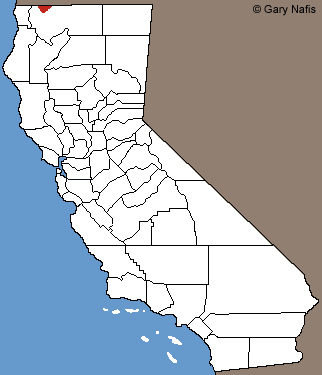|
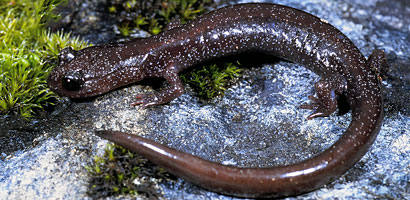 |
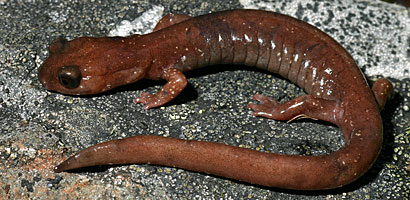 |
| Adult, Siskiyou County |
Adult, Siskiyou County |
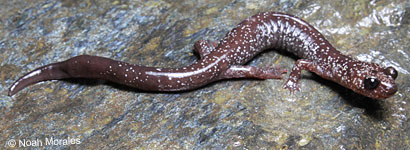 |
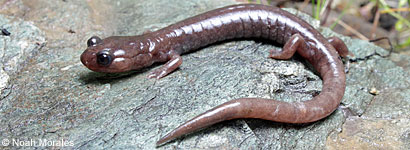 |
| Adult, Siskiyou County © Noah Morales |
Adult, Siskiyou County © Noah Morales |
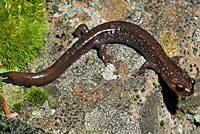 |
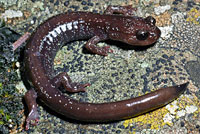 |
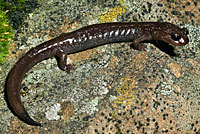 |
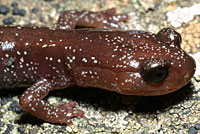 |
| Adult, Siskiyou County |
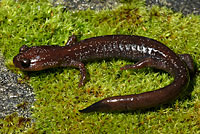 |
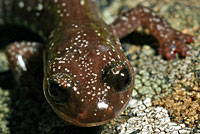 |
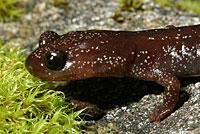 |
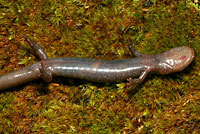 |
| |
Adult, Siskiyou County |
|
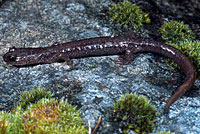 |
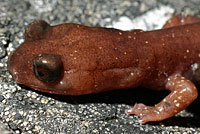 |
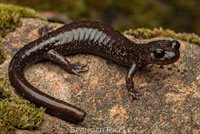 |
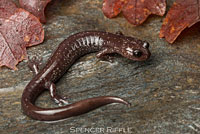 |
| Adult, Siskiyou County |
Adult, Siskiyou County |
Adult, Siskiyou County
© Spencer Riffle |
Adult, Siskiyou County
© Spencer Riffle |
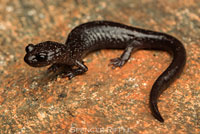 |
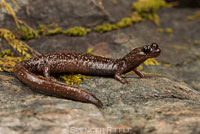 |
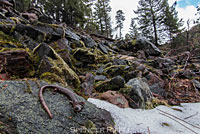 |
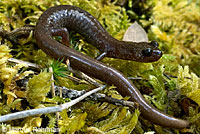 |
Adult, Siskiyou County
© Spencer Riffle |
Adult, Siskiyou County
© Spencer Riffle |
Adult in habitat, Siskiyou County
© Spencer Riffle |
Adult, Siskiyou County
© Marcus Rehrman |
| |
|
|
|
| Juveniles |
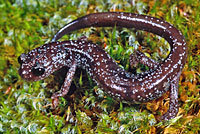 |
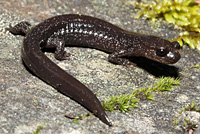 |
 |
| Juvenile, Siskiyou County |
Sub-adult, Siskiyou County |
Juvenile about 2 inches total length (5.08 cm) Siskiyou County © Noah Morales |
| |
|
|
|
| Habitat |
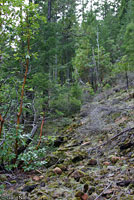 |
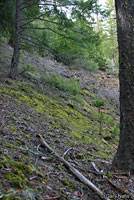 |
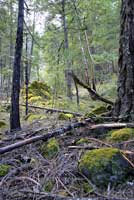 |
|
Habitat, Siskiyou County
|
Habitat, Siskiyou County
|
Habitat, Siskiyou County |
|
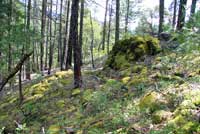 |
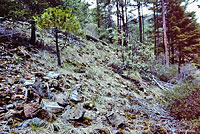 |
|
|
| Habitat, Siskiyou County |
Habitat, 2,600 ft., Siskiyou County |
|
|
| |
|
|
|
| Short Video |
| |
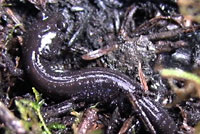 |
|
|
| |
A rock is overturned exposing a
Siskiyou Mountains Salamander. |
|
|
|
|
|
|
| Description |
| |
| Size |
Adults measure 2 3/4 - 3 inches long (7 cm) from snout to vent, and 4 1/3 - 5 1/2 inches (14 cm) in total length.
|
| Appearance |
A slender, elongated salamander with short limbs, nasolabial grooves, and usually 17 costal grooves with 4-5 intercostal folds between adpressed limbs.
Toes are short and slightly webbed. |
| Color and Pattern |
Color is light brown to purplish brown above, with profuse whitish or yellow speckling overall, more concentrated on the limbs and sides.
May show a faint light brown stripe or none at all.
The belly is grayish purple with light flecks. |
| Juveniles |
Juveniles are black with an olive-tan stripe and a dark venter.
|
| Life History and Behavior |
A member of family Plethodontidae, the Plethodontid or Lungless Salamanders.
Plethodontid salamanders do not breathe through lungs. They conduct respiration through their skin and the tissues lining their mouth. This requires them to live in damp environments on land and to move about on the ground only during times of high humidity. (Plethodontid salamanders native to California do not inhabit streams or bodies of water but they are capable of surviving for a short time if they fall into water.)
Plethodontid salamanders are also distinguished by their naso-labial grooves, which are vertical slits between the nostrils and upper lip that are lined with glands associated with chemoreception.
All Plethodontid Salamanders native to California lay eggs in moist places on land.
The young develop in the egg and hatch directly into a tiny terrestrial salamander with the same body form as an adult.
(They do not hatch in the water and begin their lives as tiny swimming larvae breathing through gills like some other types of salamanders.) |
| Activity |
Terrestrial, active on rainy or wet nights.
Activity period is probably limited to late winter and early spring, and possibly early fall, due to the summer dryness and winter freezing of the habitat.
These salamanders go deep underground during dry summer conditions, but they may emerge to feed on the surface on wet nights.
Recapture studies have shown that the sibling species P. elongatus moves very little in a single year - staying within a 7.5 square meter area, and it is thought that P. stormi has similar sedentary behavior. |
| Diet and Feeding |
Eats small invertebrates, including spiders, mites, beetles, and moths.
A sit-and-wait predator, quickly jumping from a hiding spot to grab prey. |
| Reproduction |
Little is known about the breeding behavior of this species.
Reproduction is terrestrial.
With the similar allopatric species P. elongtus, mating occurs in the spring, with females laying eggs in rocky underground nests in spring or early summer and brooding them until they hatch in the fall.
|
| Young |
Young develop completely in the egg, hatch fully formed and probably remain underground until the following spring.
|
| Habitat |
Strongly associated with rocky forested areas, especially talus in older forests.
The largest populations are found in heavily wooded north-facing slopes with rocky talus.
Mostly found in talus slopes or rock crevices, but may move into the forest during very wet periods and reside beneath woody debris.
|
| Geographical Range |
Found in a very small area of the Siskiyou Mountains in extreme northern Siskiyou county and in the Applegate River drainage in southern Oregon.
|
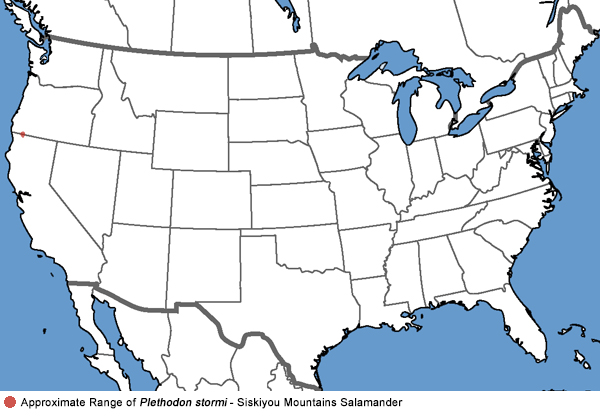 |
| Elevational Range |
Occurs at elevations of 1,600 - 3,500 ft. (488 -1078 m).
|
| Notes on Taxonomy |
P. stormi was first described in 1965.
Some herpetologists name this salamander P. e. stormi, a subspecies of P. elongatus, making the coastal form, the Del Norte Salamander, P. e. elongatus.
P. stormi was most likely separated from P. elongatus when glaciars separated inland populations from the coastal populations.
P. stormi may hybridize with P. elongatus on the southern side of the Siskiyou Mountains.
Alternate and Previous Names (Synonyms)
Plethodon stormi - Siskiyou Mountains Salamander (Stebbins & McGinnis 2012)
Plethodon elongatus stormi - Siskiyou Mountains Salamander (Stebbins 1985, 2003)
Plethodon elongatus - Del Norte Salamander (Storer 1925, Bishop 1943, Stebbins 1954, 1966)
Plethodon elongatus (Van Denburgh 1916)
|
| Conservation Issues (Conservation Status) |
| Designated as a threatened species by the state due to limited range and fragile forest talus microhabitat which is easily destroyed. |
|
| Taxonomy |
| Family |
Plethodontidae |
Lungless Salamanders |
Gray, 1850 |
| Genus |
Plethodon |
Woodland Salamanders |
Tschudi, 1838 |
Species
|
stormi |
Siskiyou Mountains Salamander |
Highton and Brame, 1965 |
|
Original Description |
Highton and Brame, 1965 - Pilot Register of Zoology, Card No. 20, 1-2
from Original Description Citations for the Reptiles and Amphibians of North America © Ellin Beltz
|
|
Meaning of the Scientific Name |
Plethodon: Greek - fullness or full of & teeth , refers to the number of vomerine & pre-vomerine teeth.
stormi: honors Robert M. Storm
from Scientific and Common Names of the Reptiles and Amphibians of North America - Explained © Ellin Beltz
|
|
Similar Neighboring Salamanders |
Plethodon elongatus - Del Norte Salamander
Plethodon dunni - Dunn's Salamander
Plethodon asupak - Scott Bar Salamander
|
|
More Information and References |
California Department of Fish and Wildlife
AmphibiaWeb
Thelander, Carl G., editor in chief. Life on the Edge - A Guide to California's Endangered Natural Resources - Wildlife. Berkeley: Bio Systems Books, 1994.
Stebbins, Robert C., and McGinnis, Samuel M. Field Guide to Amphibians and Reptiles of California: Revised Edition (California Natural History Guides) University of California Press, 2012.
Stebbins, Robert C. California Amphibians and Reptiles. The University of California Press, 1972.
Flaxington, William C. Amphibians and Reptiles of California: Field Observations, Distribution, and Natural History. Fieldnotes Press, Anaheim, California, 2021.
Samuel M. McGinnis and Robert C. Stebbins. Peterson Field Guide to Western Reptiles & Amphibians. 4th Edition. Houghton Mifflin Harcourt Publishing Company, 2018.
Stebbins, Robert C. A Field Guide to Western Reptiles and Amphibians. 3rd Edition. Houghton Mifflin Company, 2003.
Behler, John L., and F. Wayne King. The Audubon Society Field Guide to North American Reptiles and Amphibians. Alfred A. Knopf, 1992.
Powell, Robert., Joseph T. Collins, and Errol D. Hooper Jr. A Key to Amphibians and Reptiles of the Continental United States and Canada. The University Press of Kansas, 1998.
Bartlett, R. D. & Patricia P. Bartlett. Guide and Reference to the Amphibians of Western North America (North of Mexico) and Hawaii. University Press of Florida, 2009.
Bishop, Sherman C. Handbook of Salamanders. Cornell University Press, 1943.
Lannoo, Michael (Editor). Amphibian Declines: The Conservation Status of United States Species. University of California Press, June 2005.
Petranka, James W. Salamanders of the United States and Canada. Smithsonian Institution, 1998.
Corkran, Charlotte & Chris Thoms. Amphibians of Oregon, Washington, and British Columbia. Lone Pine Publishing, 1996.
Jones, Lawrence L. C. , William P. Leonard, Deanna H. Olson, editors. Amphibians of the Pacific Northwest. Seattle Audubon Society, 2005.
Leonard et. al. Amphibians of Washington and Oregon. Seattle Audubon Society, 1993.
Nussbaum, R. A., E. D. Brodie Jr., and R. M. Storm. Amphibians and Reptiles of the Pacific Northwest. Moscow, Idaho: University Press of Idaho, 1983.
|
|
|
The following conservation status listings for this animal are taken from the January 2024 State of California Special Animals List and the January 2024 Federally Listed Endangered and Threatened Animals of California list (unless indicated otherwise below.) Both lists are produced by multiple agencies every year, and sometimes more than once per year, so the conservation status listing information found below might not be from the most recent lists. To make sure you are seeing the most recent listings, go to this California Department of Fish and Wildlife web page where you can search for and download both lists:
https://www.wildlife.ca.gov/Data/CNDDB/Plants-and-Animals.
A detailed explanation of the meaning of the status listing symbols can be found at the beginning of the two lists. For quick reference, I have included them on my Special Status Information page.
If no status is listed here, the animal is not included on either list. This most likely indicates that there are no serious conservation concerns for the animal. To find out more about an animal's status you can also go to the NatureServe and IUCN websites to check their rankings.
|
| Organization |
Status Listing |
Notes |
| NatureServe Global Ranking |
G3? |
Vulnerable? |
| NatureServe State Ranking |
S3 |
Vulnerable |
| U.S. Endangered Species Act (ESA) |
None |
|
| California Endangered Species Act (CESA) |
ST |
Listed as Threatened 6/27/1971
|
| California Department of Fish and Wildlife |
None |
|
| Bureau of Land Management |
None |
|
| USDA Forest Service |
S |
Sensitive |
| IUCN |
EN |
Endangered |
|
|
|






























